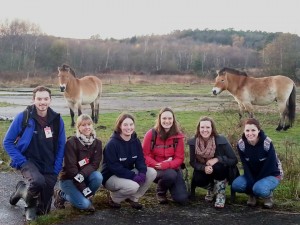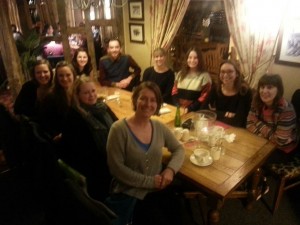Hi, my name is Eleanor and I’ll be filling you in on our activities post-Kenya!
Since we returned from Kenya, we’ve been keeping ourselves busy with another round of lectures and seminars, a few assignments, a couple of road trips, our first test and of course, Christmas dinner! It’s been our busiest time yet but we’ve somehow managed to juggle everything and have a great time whilst doing so!
As part of our lectures on reintroductions, Dr Mark Stanley-Price (Senior Research Fellow at WildCRU, Oxford, Chair of a Task Force of the Reintroduction and Invasive Species Specialist Groups responsible for revising the IUCN’s 1998 Reintroduction Guidelines, and Marwell Trustee!) came to one of our seminars to discuss his views on reintroductions and challenge what we thought of it. This is becoming a very topical issue as wild populations of so many species are declining and talks of re-wilding are increasing so this discussion with Mark was an excellent opportunity to hear from the very best on this subject!
Though not strictly part of our course, on 6th December we took a day off lectures and headed up to London Zoo for The ASAB Winter Conference. It focused on the evolution of behavioural mechanisms; I thought the first couple of talks were fairly brain-taxing but they were all on really interesting topics and the speakers were so enthusiastic about what they were studying. Many of the talks had associated posters displayed, giving us a chance to mingle with some pretty important people in the coffee break! Only one of us had previously gone to a conference of this nature, so it was an inspiring day and we’re already looking at others we could attend!
Our next road trip was pretty much the polar opposite of the high lights of London; we drove to Farnborough and met Dr Martin Wilkie (Marwell UK Reserves Manager) who showed us around Eelmoor Marsh, a SSSI jointly managed by Marwell Wildlife and Qinetic, the owners of the site. We started the afternoon with our final lecture of the term on habitat restoration before heading onto the marsh to look around and spot the Przewalski’s horses, resident on the site. Some of the staff at Marwell had told us about Eelmoor’s winter works that take place for a few weeks a year and we saw them in action when we visited. The aim of this undertaking is to control scrub encroachment and to remove key invasive species, in turn diversifying the habitat. Ultimately, Marwell works to restore the lowland heath habitat and to conserve and enhance the key biological communities at Eelmoor. While it looked rather extreme with diggers and managed fires, Martin explained what they were doing and why it would benefit the marsh and we got to see areas that had been managed in previous years. There’s more than 400 species of conservation concern already identified at Eelmoor so they’re doing a great job! We saw all five Przewalski’s Horses, they were all curious and a couple came closer to say Hi! It was a privilege to visit this site; I’m looking forward to undertaking research on Eelmoor for my project and am hoping to lure the others back to help with data collection under the pretext of meeting the highland cattle too…!
The day after our road trip to Eelmoor, we had a reality-check with the competency test for the Techniques in Monitoring and Surveying module. The great thing about this course is it’s so focused on teaching you what you need to know to become a conservation scientist and thus has a very large practical element to it. This exam, which was our first, consisted of each of us in turn talking about and demonstrating two bits of equipment chosen by Programme Managers Dr Judith Lock (University of Southampton) and Dr Heidi Mitchell (Marwell Wildlife). We had to explain how they worked and how to correctly set them up, how to maintain them, the situations you could use them in, what data they yielded, how this data could be used and any equipment/software that would help analyse the data. I demonstrated a camera trap and a GPS and overall I was rather pleased with it! A few of us spent the rest of the day putting our knowledge into practice by helping keepers set up camera traps in their animal enclosures to monitor movements.
Over our first term on the MRes we got to do so many exciting and interesting things, we learnt so much and got to know each other, the conservation team at Marwell and our university lecturers really well. It has been an amazing and rather busy term and needed a suitable finale so we organised a Christmas dinner at a pub near Marwell for a festive celebration, lots of laughs and a mountain of good food! I think I can say on behalf of all of us that it really was a great end to an absolutely fantastic term!
Check back here soon to see the next blog post about our pretty awesome adventures in Kenya, it’ll be a post definitely worth a read…!
Merry Christmas!
Written by Eleanor Rendells
Posted By : Eleanor Rendells


